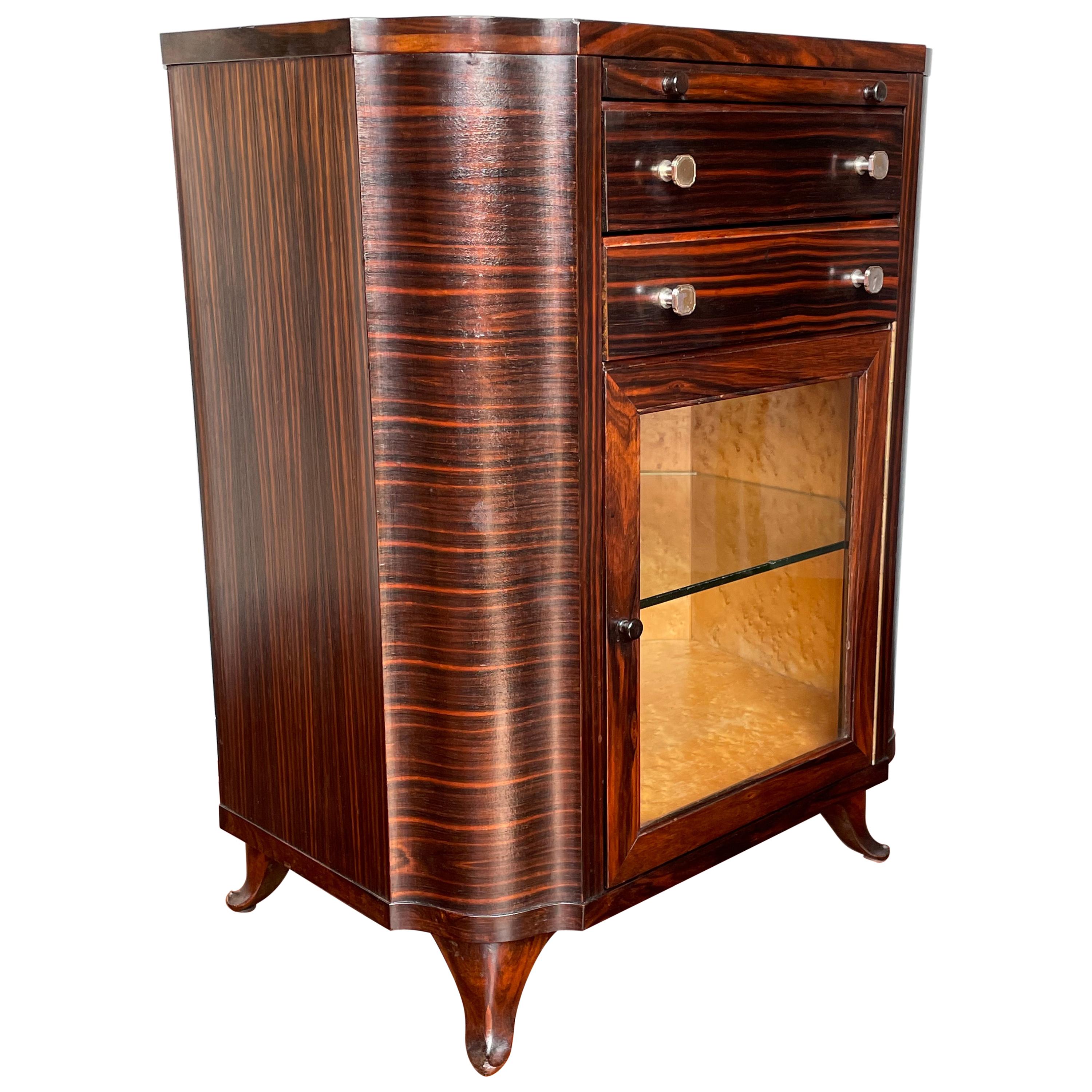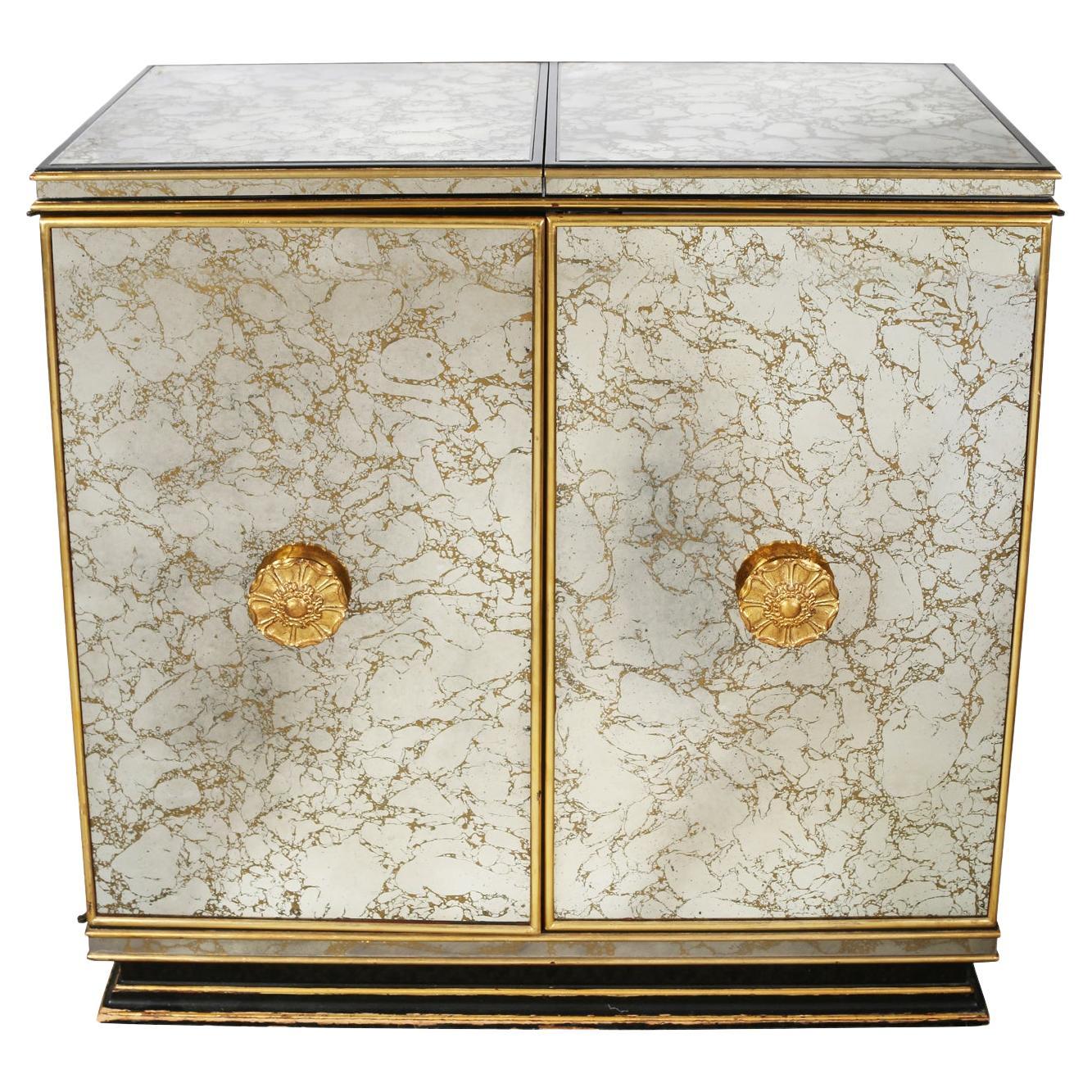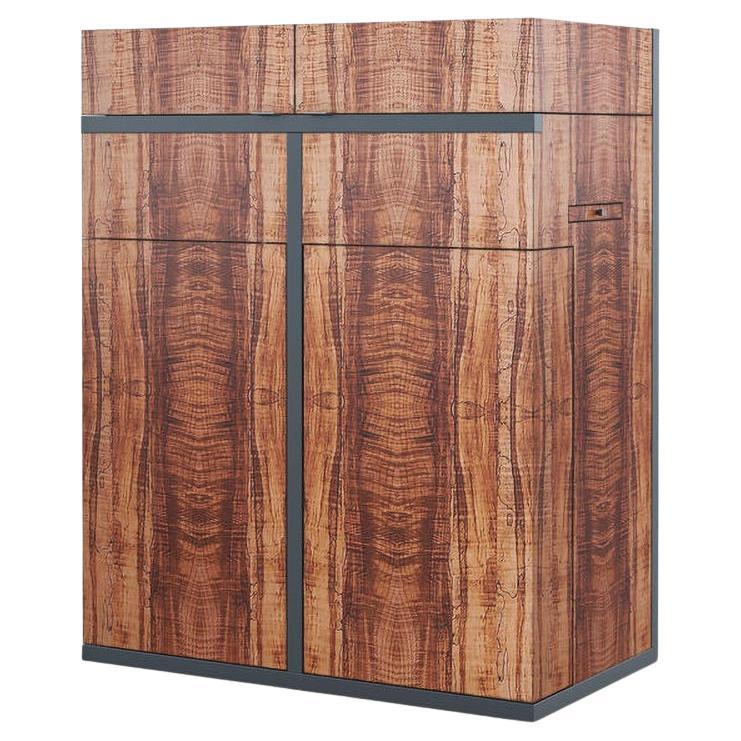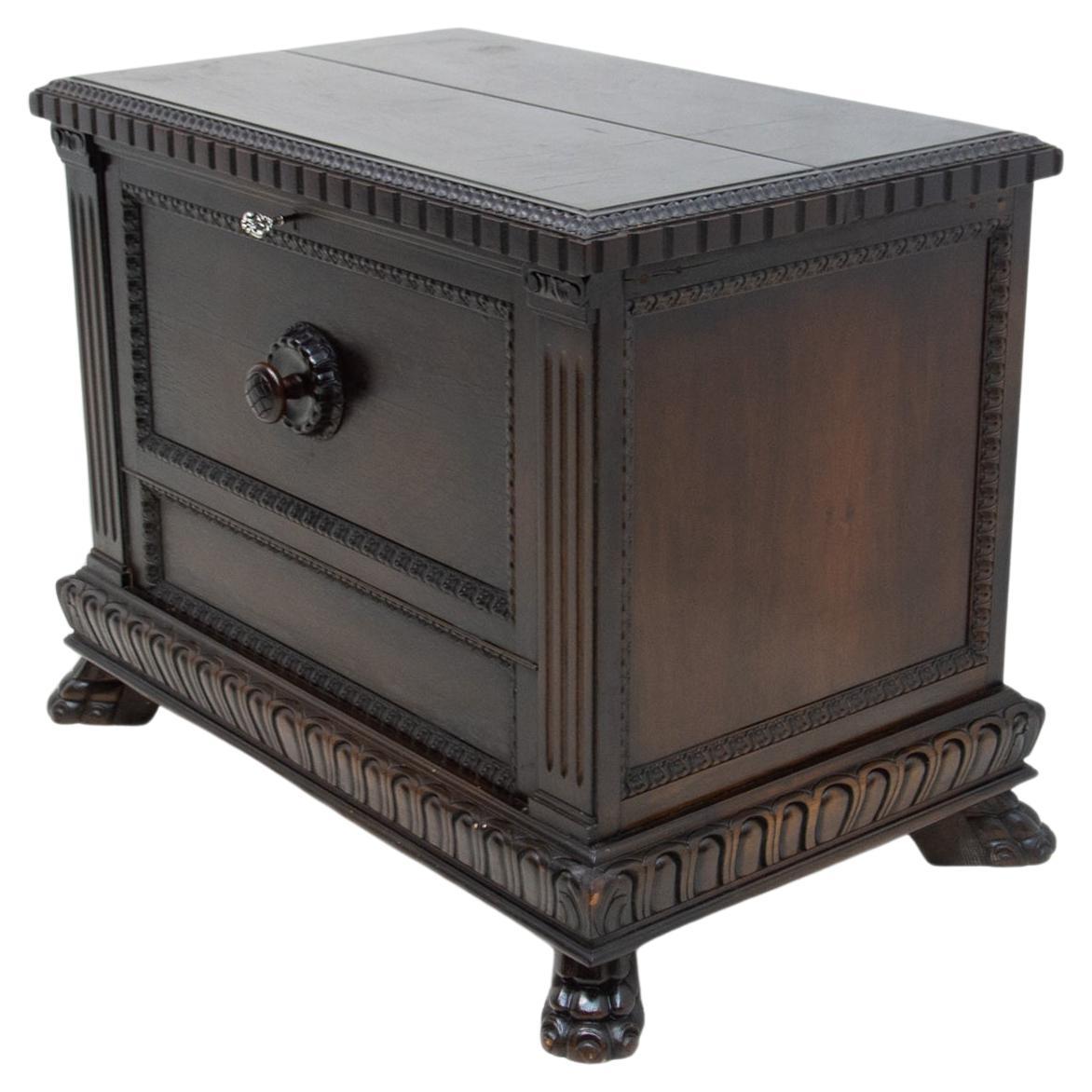Items Similar to Rare László Hoenig London Art Deco Mirrored Drinks Bar Cabinet Leather Maple
Want more images or videos?
Request additional images or videos from the seller
1 of 21
Rare László Hoenig London Art Deco Mirrored Drinks Bar Cabinet Leather Maple
About the Item
English:
A rare straight designed bar cabinet by László Hoenig
the 4 front doors are lined with goat skin - brassed fittings - bakelite handles - mirrored inside
it comes with its 2 original keys - on the upper board is fitted with a 4mm thick glass board
please ask for shipping quote
Deutsch:
straightes Möbelstück mit Ziegenleder Front
innen verspiegelt - Messingbeschläge - Bakelitgriffe - abschließbar mit Originalschlüssel
Ablage oben mit einer 4mm Glasplatte auf honigfarbenen Ahorn Holz eingepasst
László Hoenig (1905-1971) was a modernist architect,
interior designer and cabinet-maker. Born in the last decades of the Austro-Hungarian empire,
he studied in Germany at the Bauhaus in the late 1920s and practised in Berlin until 1933,
when he emigrated to Britain.
He set up a design studio and showroom in central London, running a successful business as
an interior designer and maker of bespoke furniture,
working mostly for private and corporate clients, until his death in 1971 - Essay from National Trust website.
Maße / measurements:
komplett/total : H/height: 123 cm ~ B max / max width: 83 cm ~ T/depth: 39 cm
nur oben / upper cabinet: 121 cm x 57 cm.
- Creator:Laszlo Hoenig (Designer)
- Dimensions:Height: 48.43 in (123 cm)Width: 32.68 in (83 cm)Depth: 15.36 in (39 cm)
- Style:Art Deco (Of the Period)
- Materials and Techniques:
- Place of Origin:
- Period:
- Date of Manufacture:1942-1952
- Condition:Additions or alterations made to the original: mirrors have been replaced inside. Minor structural damages.
- Seller Location:Kumhausen, DE
- Reference Number:1stDibs: LU8587234299192
About the Seller
5.0
Gold Seller
These expertly vetted sellers are highly rated and consistently exceed customer expectations.
1stDibs seller since 2023
9 sales on 1stDibs
Typical response time: 2 hours
- ShippingRetrieving quote...Ships From: Bodenkirchen , Germany
- Return PolicyA return for this item may be initiated within 10 days of delivery.
More From This SellerView All
- Midcentury Cocktail Bar Made in England a. Umberto Mascagni Drinks Bar CounterBy Umberto MascagniLocated in Kumhausen, DEThis spectacular English Cocktail Bar is in amazing good condition - fully revised and rewired. Its solid wooden body is veneered with Tola Wood. (botanic name: Gossweilerodendron ...Category
Mid-20th Century English Mid-Century Modern Dry Bars
MaterialsGlass, Formica, Wood, Teak
- One of a Kind Italian Midcentury Sideboard with Bar Cabinet a. Vittorio DassiBy Vittorio DassiLocated in Kumhausen, DEItalian 1950s one of a kind BAR / SIDEBOARD attributed to Vittorio Dassi birch root veneer - solid birch "feet" - stained glass top - mirrored bar compartment - carved upper orna...Category
Vintage 1950s Italian Mid-Century Modern Sideboards
MaterialsStained Glass, Birch, Burl
- pair of 1960s lounge chairs green velvet - beech WG solid make uph. easy chairsLocated in Kumhausen, DEThis set of two West German lounge chairs is in very good condition It was made in the mid 1960s The armrests have been professionally restored (sanded - stained and lacquered tw...Category
Mid-20th Century German Mid-Century Modern Lounge Chairs
MaterialsBeech, Velvet, Wood
- Art Nouveau Southern French Fayance art pottery FLOOR VASE rare colours&patternLocated in Kumhausen, DEA giving joy beautiful French Fayence Floor Vase fantastic Art Nouveau pattern - Impressing Colours Manufacturer unknown - marked Design Period 1915 - 1925 Country of Manufacture : France H / height: 46 cm ~ Gew. / weight: 4550 grs DM / diameter max: 28 cm ~ DM oben / diameter inner rim: 19.8 cm .... an ode to Southern France A Legend of Provence by Adelaide Anne Procter (30 October 1825 – 2 February 1864) The lights extinguished, by the hearth I leant, Half weary with a listless discontent. The flickering giant-shadows, gathering near, Closed round me with a dim and silent fear. All dull, all dark; save when the leaping flame, Glancing, lit up a Picture's ancient frame. Above the hearth it hung. Perhaps the night, My foolish tremors, or the gleaming light, Lent power to that Portrait dark and quaint, — A Portrait such as Rembrandt loved to paint, — The likeness of a Nun. I seemed to trace A world of sorrow in the patient face, In the thin hands folded across her breast: — Its own and the room's shadow hid the rest. I gazed and dreamed, and the dull embers stirred, Till an old legend that I once had heard Came back to me; linked to the mystic gloom Of that dark Picture in the ghostly room. In the far south, where clustering vines are hung; Where first the old chivalric lays were sung; Where earliest smiled that gracious child of France, Angel and knight and fairy, called Romance, I stood one day. The warm blue June was spread Upon the earth; blue summer overhead, Without a cloud to fleck its radiant glare, Without a breath to stir its sultry air. All still, all silent, save the sobbing rush Of rippling waves, that lapsed in silver hush Upon the beach; where, glittering towards the strand The purple Mediterranean kissed the land. All still, all peaceful; when a convent chime Broke on the mid-day silence for a time, Then trembling into quiet, seemed to cease, In deeper silence and more utter peace. So as I turned to gaze, where gleaming white, Half hid by shadowy trees from passers' sight, The Convent lay, one who had dwelt for long In that fair home of ancient tale and song, Who knew the story of each cave and hill, And every haunting fancy lingering still Within the land, spake thus to me, and told The Convent's treasured Legend, quaint and old: — Long years ago, a dense and flowering wood, Still more concealed where the white convent stood, Borne on its perfumed wings the title came: " Our Lady of the Hawthorns " is its name. Then did that bell, which still rings out to-day, Bid all the country rise, or eat, or pray. Before that convent shrine, the haughty knight Passed the lone vigil of his perilous fight; For humbler cottage strife or village brawl, The Abbess listened, prayed, and settled all. Young hearts that came, weighed down by love or wrong, Left her kind presence comforted and strong. Each passing pilgrim, and each beggar's right Was food, and rest, and shelter for the night. But, more than this, the Nuns could well impart The deepest mysteries of the healing art; Their store of herbs and simples was renowned, And held in wondering faith for miles around. Thus strife, love, sorrow, good and evil fate, Found help and blessing at the convent gate. Of all the nuns, no heart was half so light, No eyelids veiling glances half as bright, No step that glided with such noiseless feet, No face that looked so tender or so sweet, No voice that rose in choir so pure, so clear, No heart to all the others half so dear, So surely touched by others' pain or woe, (Guessing the grief her young life could not know,) No soul in childlike faith so undefiled, As Sister Angela's, the " Convent Child. " For thus they loved to call her. She had known No home, no love, no kindred, save their own. An orphan, to their tender nursing given, Child, plaything, pupil, now the Bride of Heaven And she it was who trimmed the lamp's red light That swung before the altar, day and night; Her hands it was whose patient skill could trace The finest broidery, weave the costliest lace; But most of all, her first and dearest care, The office she would never miss or share, Was every day to weave fresh garlands sweet, To place before the shrine at Mary's feet. Nature is bounteous in that region fair, For even winter has her blossoms there. Thus Angela loved to count each feast the best, By telling with what flowers the shrine was dressed. In pomp supreme the countless Roses passed, Battalion on battalion thronging fast, Each with a different banner, flaming bright, Damask, or striped, or crimson, pink, or white, Until they bowed before a newborn queen, And the pure virgin Lily rose serene. Though Angela always thought the Mother blest Must love the time of her own hawthorn best, Each evening through the years, with equal care, She placed her flowers; then kneeling down in prayer, As their faint perfume rose before the shrine, So rose her thoughts, as pure and as divine. She knelt until the shades grew dim without, Till one by one the altar lights...Category
Vintage 1910s French Art Nouveau Vases
MaterialsPottery
- Pair of Tender Rose Murano Barovier e Toso Chandeliers Blown Pendants Art DecoBy BarovierLocated in Kumhausen, DEGorgeous pair of Barovier e Toso Italian Murano art glass chandeliers Blush tender rose glass with its original E27 ceramic sockets in excellent condition. Can be fittet both opt...Category
Vintage 1930s Italian Art Deco Chandeliers and Pendants
MaterialsBrass
- Art Deco Floor Vase Attr to Michael Powolny Wiener Keramik Schleiss GmundenBy Michael PowolnyLocated in Kumhausen, DEArt Deco floor vase attr. to Michael Powolny / Wiener Keramik / Schleiss Keramik Gmunden „Vereinigte Wiener und Gmundner Keramik und Gmundner Tonwarenfabrik Schleiss, Ges.m.b.H.“ height: 52cm - diameter: 32.5cm - diameter rim: 16.5cm - weight: 7.7 kg From a noble estate in Linz / Austria - in amazing good condition Michael Powolny Michael Powolny (* 18. September 1871 in Judenburg, Österreich-Ungarn; † 4. Jänner 1954 in Wien) war ein österreichischer Keramikdesigner, Bildhauer und Medailleur. Leben Nach Abschluss einer Hafnerlehre besuchte Powolny von 1891 bis 1894 die Fachschule für Tonindustrie in Znaim, daran anschließend von 1894 bis 1901 die Wiener Kunstgewerbeschule. 1906 gründete er gemeinsam mit Bertold Löffler die Wiener Keramik, deren Vertrieb bereits nach etwa einem Jahr von der Wiener Werkstätte übernommen wurde. 1913 kam es zum Zusammenschluss der Wiener Keramik mit der Gmundner Keramik (Vereinigte Wiener und Gmundner Keramik und Gmundner Tonwarenfabrik Schleiss Gesellschaft m. b. H.). Michael Powolny wirkte von 1909 bis 1936 als Lehrer an der Kunstgewerbeschule. Seine Arbeiten, die ab 1929 dem Art déco zugeordnet werden können,[1] wurden auf zahlreichen internationalen Ausstellungen gezeigt und erzielen bei Sammlern hohe Preise. Powolny wurde von Josef Hoffmann bei der Ausstattung des Cabaret Fledermaus und des Palais Stoclet sowie bei der Gestaltung mehrerer großer Villenbautenin Wien herangezogen. Auch der Entwurf für die neue österreichische Ein- und Zwei-Schilling-Münze von 1946 bis 1952 stammt von Powolny. Er stand 1944 in der Gottbegnadeten-Liste des Reichsministeriums für Volksaufklärung und Propaganda. Anlässlich seines 80. Geburtstages wurde Powolny 1951 mit der Ehrenmedaille der Bundeshauptstadt Wien ausgezeichnet. Powolny wurde in einem ehrenhalber gewidmeten Grab auf dem Wiener Zentralfriedhof bestattet. 1965 wurde im 22. Wiener Gemeindebezirk die Powolnygasse nach ihm benannt. Gmundner Keramik – Schleiss Keramik Die „Gmundner Keramik“, wie wir sie heute kennen, ging aus einem im Jahr 1903 von Leopold Schleiss unter dem Namen „Gmundner Thonwaren-Fabrik“ (anfangs Thonwaren mit „h“) errichteten Betrieb in Traunleiten, heute Keramikstraße Gmunden, hervor. Schon im Jahre 1843 kauften die Eltern von Leopold Schleiss in Gmunden die „Hafnerhäuser am See“, heute Theatergasse 14 und 16, und übten dort ihr Hafnergewerbe aus. 1883 übernahm Leopold die gut gehende und deshalb bald an ihre räumlichen Grenzen stoßende Werkstätte. Dies führte zum Kauf eines Grundstückes im oberhalb von Gmunden gelegenen Traunleiten, auf dem 1903 eine neue Fabrikationsstätte errichtet wurde. Leopolds Sohn Franz Schleiss II (geb. 1884) zeigte großes handwerkliches und künstlerisches Talent und entwickelte sich zum überzeugten Vertreter der um die Jahrhundertwende aufkommenden neuen Kunstströmungen. Bereits 1907 waren mehrere Künstler und Künstlerinnen für das Unternehmen tätig, und Fayencen wie Kleinplastiken wurden auf Ausstellungen gezeigt. Nach seiner 1909 erfolgten Verehelichung mit der akademischen Bildhauerin Emilie Simandl, gründete er mit ihr 1910 die „Keramische Werkstätte F. u. E. Schleiss, Gmunden“. 1913 kam es zum Zusammenschluss mit der „Wiener Keramik“. Der neue Firmenname lautete „Vereinigte Wiener und Gmundner Keramik und Gmundner Tonwarenfabrik Schleiss, Ges.m.b.H.“. Die Modelle der „Wiener Keramik“ von Powolny, Löffler und anderen Künstlern gehörten nun zum künstlerischen Bestand des Unternehmens. Nach einer Zeit unglaublicher Vielfalt und Fülle an außergewöhnlichen Keramiken kam es mit Beginn des Ersten Weltkrieges, im Rahmen der am Anfang des Krieges herrschenden Hochstimmung, zu einer Sortiment Erweiterung mit „patriotischer Kunst“. Bald aber machte sich das Fehlen von zum Kriegsdienst eingezogenen Arbeitskräften bemerkbar. Mit der Gründung einer „Lehrwerkstätte für Keramik, Schleiss Schule“ steuerte Franz Schleiss dagegen und holte auf diese Weise neue Mitarbeiter in die Firma. Nach Kriegsende erzeugte er mit einigen Absolventen der Schule Unikatkeramiken, die in der „Gmundner Werkstätte, registrierte Genossenschaft m.b.H.“ erzeugt und gemeinsam mit der „Gmundner Keramik“ vertrieben wurden. 1923 wurde die „Gmundner Keramik“ in eine Aktiengesellschaft umgewandelt und firmierte nun unter „Gmundner Keramische Werkstätten A.-G.“. Meinungsverschiedenheiten führten 1926 zum Austritt des Ehepaares Schleiss, welches daraufhin die „Josefine Schleiss Gmundner Keramik“, die spätere „Schleiss Keramik“, und in Deutschland die „Münchner Werkstätte...Category
Vintage 1930s Austrian Art Deco Vases
MaterialsPottery
You May Also Like
- Exquisite French Art Deco Coromandel & Birdseye Maple Drinks Cabinet w. DrawersLocated in Lisse, NLStunning small size Art Deco cabinet with silvered bronze handles on the drawers. When it comes to antiques, somehow we have always known what to buy w...Category
Early 20th Century French Art Deco Dry Bars
MaterialsBronze
- SELVA Italy Art Deco Style Mirrored Bar CabinetBy SelvaLocated in Doylestown, PAExquisite Art Deco mahogany bar cabinet with drop front door by SELVA, Italy. This is a stunning cabinet expertly handcrafted by one of Italy's premier luxury furniture houses, S...Category
Early 2000s Italian Art Deco Dry Bars
MaterialsStainless Steel
- Art Deco Style Antiqued Mirror Bar CabinetLocated in Locust Valley, NYAn Art Deco style, vintage cabinet clad in antiqued mirror with gilt detail and round hardware. The deco style cabinet top extends on each side and opens to reveal a black storage tray. The antiqued mirror cabinet...Category
Mid-20th Century Cabinets
MaterialsMirror
- French Art Deco Bar CabinetLocated in Westwood, NJA French Art Deco style bar cabinet, reminiscent of the roaring, 1920s. Decked out with églomisé glass and gilt painted lines. The classic c...Category
21st Century and Contemporary Vietnamese Art Deco Dry Bars
MaterialsBrass
- Maple Modern Bar CabinetLocated in Westwood, NJMaple Modern bar cabinet, luxury, understated: this sleek bar cabinet mixes form and function with innovation to elevate entertaining. Well-suited ...Category
21st Century and Contemporary Asian Modern Dry Bars
MaterialsWood
- Art Deco Walnut Bar Cabinet, 1930sLocated in Prague 8, CZMade in the 1930s in the former Czechoslovakia, material: walnut, glass, metal. Inside, a metal container for placing bottles and glasses. Carved legs of the dresser in the shape of ...Category
Mid-20th Century Czech Art Deco Dry Bars
MaterialsMetal
Recently Viewed
View AllMore Ways To Browse
Bar Cabinet Sink
Brigitte Bar
Rattan Wine Rack
1940s Art Deco Regency Bar
Bar Cabinet With Sink
Burr Walnut Art Deco Bar
Pop Up Bar Cabinet
Rattan Tiki Bar
Bar Cabinet Wheeled
French Dry Sink
Giraffe Bar
Henredon Flip Top
Paolo Buffa Drinks Cabinet
Wooden Wine Cabinet Antique
Dry Bar Corner Unit
Vintage Dry Sink
Vintage Queen Anne Mirror
Antique Reception Counter





